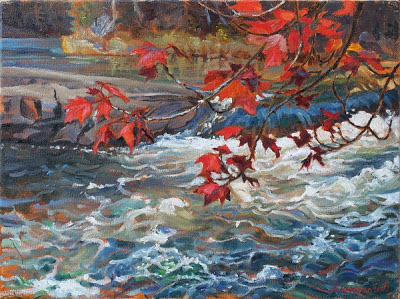Autumn Honesty (oil on canvas 5 x 7 in.) Sold
2 November finds me sitting in the "forever wild" thicket behind our house in Bishops Mills, painting the translucent parchment disks of Honesty (or Money Plant) Lunaria annua. The basal leaves of the first year plants of this biennial make bright notes of green among the dry fallen leaves. The sun is warm and I'm sheltered from the light wind, only a few degrees above freezing.
Manitoba Maples have long shaded this spot, making it cool and mossy in the summer. For more than 30 years we've watched the wild plums and buckthorn growing up and the Honesty spreading underneath them. At first this European introduction was just a curiosity to us because it had such nice seed pods, bright magenta blooms, and it was edible in the spring. About the time it was discovered that Garlic Mustard, also introduced from Europe, breaks down fungal symbiosis in Ontario forests, we began to suspect that Honesty, which is also a shady woods mustard, may have the same effect of actively suppressing the ability of the soil to support native plants.
We had set this spot aside as the 10% of the house lot that was to be forever wild, without any human intervention, but invasive species were becoming so common that we've decided to take action against them in 2008, cutting out Buckthorn, Honeysuckle, and Black Locust. We also started to pull the Honesty plants as soon as they flowered, and carefully take out the dead second-year stems with their unopened seed pods. There are only a few of them left now in the densest part of the thicket, where previous falls they were a galaxy of glimmering silvery coins.
Today we tried the basal leaves as an autumn harvest of cooked greens and found them in texture like cooked nettles, with a mild kale flavour.




Comments
Post a Comment
What do you think of this painting, and what do you know about the subject that I have painted?